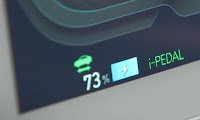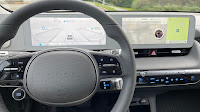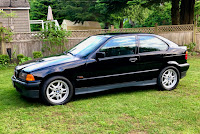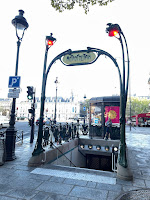Travel and Leisure
Ok, so this isn't going to be a history lesson - that's not what I mean by the title; it's more like "what I learned about travelling on our own in France". Let me start by saying that this wasn't our first time there, as we'd stopped at a few places on our 2009 Rhine river cruise, but it was definitely our longest French visit, at 19-nights. See, when you're on a guided tour, as most of a river cruise itinerary is, you're not really getting much local culture, as I commented recently in
the FB Group. You're typically surrounded by Americans and you eat most of your meals on the ship, not getting immersed in the people and surroundings. Sure, you get a neat, guided walking tour in each port, where a local explains the history and sights, but it's all taken care of for you. No language barriers, no (or not much) navigating on your own, and certainly not having to find a decent restaurant. What was/is great about river cruises, is that you get a taste of a lot of places, without having to pack and unpack every day, as you're essentially on a floating boutique hotel that follows you along the river.
 |
| We were all over Colmar |
On our Rhine cruise, we loved the Alsatian town of Colmar and the nearby Wine Route villages, so we put that on our self-guided itinerary for a solid 5-nights. With almost three weeks for France, I decided that we'd use the high-speed TGV to get around, keeping any particular day's travel to around 2 hours or less. That put stops in the Champagne region, continuing to the Alsace, then down to Burgundy, and back to Paris to close it off the loop. So in no particular order of importance, here are some of the things I learned about travelling in France.
France requires pre-planning
 |
| Some pre-France planning |
What I mean by this, is planning that is beyond what I'm assuming that all of you would do when going on a self-guided, European trip; booking airfare and accommodations is a given, but there are a number of other considerations that require your attention long before you start packing your bags. Sure, during the course of booking your hotels or Airbnbs, you needed to decide, "how many nights do we need in Dijon?" and that sent you off to Google to figure out what day trips you would do while staying in Burgundy. Exploring by car? Book it as soon as you can; prices usually go up as you get closer to departure date. If they go down, you can just cancel and re-book at the lower price.
Read more here.
Using the TGV system: If you're going to be using the TGV (Train à Grande Vitesse), that's where you might need to start planning ahead, as the lowest fares go on sale about three months in advance. Yes, I know that this does kinda lock in your schedule, but you can change your tickets, only paying the difference in fare (if applicable).
 |
| TGVs are fast and efficient |
This pre-planning only worked against us once, where I should have purchased morning tickets from Colmar to Besançon, and spent the day there, rather than backtracking as a separate day-trip. I purchased the
SNCF Carte Avantage, which at 49€ may or may not save you money; I found out later that the discounts that this card entitles you to, are strangely applied, or not at all. We saved on only about half our TGV trips, but it also worked for some REB (regional) train prices as well. Only one person in your party of two needs to buy the Carte Avantage, as you can purchase tickets for the both of you on
the SNCF app, and the discount will automatically be applied. In the end, we saved about 40€ using the Carte Avantage.
Advance tickets for museums: This is really only a consideration for Paris and Versailles, as these venues attract huge mobs of tourists, even in off-season times. This is where the French quirkiness kicks in, as not all museums and attractions use the same booking system, and rules change depending on which site you want. Combine that with the fact that the Paris Museum Pass (PMP) is separate entirely, it makes for very confusing planning. I'll save you the trouble, and say that the 48-hour PMP is worth it, if you plan on hitting the biggies plus Versailles one day.
 |
| You'll want to book ahead for the Louvre |
You should
pre-book times for the Louvre, L'Orangerie, Saint Chapelle and Versailles; again, since these are separate sites, the window for advance booking varies wildly. We happened to be in Paris on the first Sunday of the month, so most museums were free, but we stayed away from the popular ones, and hit the Cluny and Rodin museums. We had planned on stopping at Les Invalides to see only Napoleon's tomb, but it was the end of Fashion Week, and the Army Museum was closed for some event. Unlike most visitors to Paris, we felt that the Eiffel Tower was a great monument to see, but not necessarily worth the price/time/hike to go up; those that do want to see the view from there should book ahead (not covered by the PMP).
Restaurants and other things: We're not foodies and as such, didn't bother to research the best restaurants in each city and make reservations. You can make wine tour reservations in advance, which we would recommend, after waltzing up to the Martel champagne house, only to find that they only open on specific days and times in the off-season. We went on a walking tour with a local in Nancy using a free service called "Nancy Greeters"; this required booking a week in advance, and was definitely worth it.
To explore the Wine Route in the Alsace region, we had booked a hop-on, hop-off
shuttle called Kut'zig, which stops at a half-dozen neat little villages. It seemed like a much better idea than renting a car, which is really the only other way to explore the area in a day. But in practice, it failed, as despite being a reservation-only system, they seem to have overbooked on the first day we tried it. We waited by the Unterlinden in Colmar, but the shuttle filled up at the first stop (Colmar train station), and they didn't send a backup overflow one. Similarly, on the the next day when we did get to use it, they left passengers behind at Eguisheim; those folks had to wait another 90 minutes for the next one and queue up again.
Parlez-vous Français?
As Canadians, we get taught/are forced to learn French in high school, the latter because if you wanted to go on to university, you had to have French. This rule might have changed since then, but I resented having to learn it in my youth for that reason; now I regret not having kept it up. So, after booking our airfare, I started using the Duolingo app to refresh my French language skills. I would say that it helped a bit, getting me re-familiarised with the verbs and which words are masculine versus feminine.
But "le cheval mange la pomme" isn't much value in day-to-day use in Paris, and you don't have the time to compose a message on your iPad/iPhone when the bus driver blurts out something before you try boarding. However, Duolingo did help dust off my skills a bit, and I felt pretty good about my ability to ask for help, or order food etc. at restaurants. There'd be a tiny rehearsal in my head,
"avez-vous une table pour deux pour le diner s'il vous plaît?" to which the restauranteur would say,
"à l'interieur ou l'exterieur?" and then I would say,
"l'exterieur". But, what I found is that if I did a credible job of my first question, they assumed I spoke French (well), and they'd reply with a fast barrage that I could only guess at. I quickly adapted to saying something to my wife clearly in English, before asking for anything in French, and that negated that issue going forward. Menus were often in both French and English, and likely due to the advent of Covid-19, some had a QR code to scan for an English-only version (in the Alsace, the printed menu was often in French and German only).
 |
| You might need Google translate for the menu |
At one restaurant that we stopped at for a snack where the menu was only in French, I saw something called "Rillettes de Poulet Rôti"; I figured, it's roasted chicken, what could go wrong? Anyhow, a 350ml-sized jar filled with some sort of chilled pâté arrived, with some sliced baguette to spread it on. It was delicious! In general, in tourist places and restaurants, most staff will have some English skills, but it's still proper to greet them with a "bonjour" or "bonsoir" as appropriate, and "s'il vous plaît", "merci", and "au revoir" are customary everywhere. You will find that other spots like the pharmacy or supermarket that they don't speak English at all, and that's where you'll need to bumble your way through. The only time I saw a rude response from a Frenchman was when an equally rude American marched up to the bus driver and exclaimed loudly,
"Where do we get bus #69?"; she might have received a more courteous response if she had started with
"Excuse moi, parlez-vous Anglais?". Luckily, that was the extent of the stereotypical loud American tourist experience in France, but the message is, put a little bit of effort in, and you'll be greeted warmly by the locals. In a pinch, pull out your iPhone and use Google Translate.
Dining in France (and other vacation destinations)
 |
| This Alsatian dish was offered everywhere |
Speaking of eating, one of the things we've encountered in many places, not just France, is that they offer the same regional dishes over and over in a given area. For example, in Colmar and the Alsace region, there are a few menu items that get repeated in almost every restaurant in the tourist zone. This is great - for the first night or two. But after a few days in one city, we found that it was hard to find something different to eat; I'm not normally a fan of eating dishes that don't match the region, but I was definitely eyeing up that curry place on our 5th night in Paris. Actually, Paris is the one city where you can find a decent variety, but you had to go looking for it. Steak tartare? Escargot? Steak and fries? Almost EVERY Parisian restaurant offered these. We weren't yearning for North American food, but they do make a good burger in France, and I ended up having
a great one in Dijon.
Luckily for her, the French do like their vegetables and salads, although they don't seem to know exactly what goes into a Caesar salad. We ate often in brasseries, preferring the casual nature and energetic vibe over formal dining establishments. As such, meals were not too expensive, certainly not as much as I was expecting for Paris. And since you don't tip, what you see is what you pay; we only paid more than 50€ once (for dinner). While I'd say the food we can get here in Vancouver is better, on average, but once you add in the taxes and tip, the price was only about 10-15% higher in Paris. Service was expectedly lacklustre, as we've come to expect from countries where tipping is not required. The only time you'll see your server after they've dropped off your plates, is when you ask "l'addition, s'il vous plaît?". Most restaurants brought the credit card machine with the bill; in a few places, you'd go up to the counter to tap your card/phone.
Expect a lot of walking
This goes without saying for pretty much anywhere in Europe, but for some reason, everywhere we went in France, we ended up walking 10-12 kms per day! I don't recall walking as much in places like Rome or Prague, but despite best planning efforts, we wore ourselves out every day of our French vacation. I have a theory that because many places "seemed" walkable, we chose to do so, rather than take the bus or metro (if available). Actually, in many cases, the metro was not faster, and it required almost as much walking to get to and from the stations that were necessary.

In the example pictured, it would have taken us the about the same amount of time to take the Metro, and we would have only saved 500m of walking! Not to mention that you don't get to see as much of the city if you chose the metro option. But the walking can/will usually be over uneven cobblestones, which is another reason why our feet hurt so much at the end of the day. While we both brought along very good walking shoes, you can't prepare yourself for the additional pressures that the uneven pavement places on the bottoms of your feet.
And don't even think about trying to wear fashionable shoes; besides, these days the trend is "lifestyle sneakers", so make sure you've checked out some of those for your next European trip. It took weeks for our feet to recover from this trip, so we've both gone out and bought
these top-rated New Balance ones (hers are grey with white accents instead). Fashionable? I don't care - these are like walking on clouds.
Fashion is not a concern
I've written about this before - Europeans are more fashionable than North Americans. Period. While there's no arguing this, it was also not as noticeable a difference as I was expecting; I think this has slowly changed over the time that I've been travelling to Europe. Sure, we were often in tourist areas, where a lot of who you see are not locals and therefore what they are wearing is not indicative of the fashion trend.
 |
| I didn't need my blazer for this trip |
But when we were around what we assumed were real French or Parisian folks, they weren't dressed for the runway or red carpet. Admittedly, we didn't see women in Lululemon/yoga gear or guys wearing their Arc'teryx Gore-tex jackets, but I'm pretty sure we didn't look too out-of-place either. Of course we did see Americans that stuck out like sore thumbs, usually due to their baseball caps or clothing logos, but we typically "heard" them before their style choices identified them as being from the US. So unless you plan on going to the Michelin-star restaurants or traipsing down the shops on the Champs Élysées, you can pack comfortable travel clothing, without worrying too much about how you'll look. I wrote
a post on my packing choices here.Getting around can be confusing
 |
| The Owl Trail markers in Dijon |
While this one isn't unique to France, it is something that we definitely struggled with. Picture two adults hunched over an iPhone, "Where is this?" "What direction are we heading?" "Are you sure this is the right street?". Unlike many other places we've been where there's mountains, a river or an ocean to give you bearings, most of the places we visited didn't have that kind of intuitive navigational landmarks. Once in the old town areas, every street looks the same, and even Google Maps sometimes couldn't give us a correct compass bearing. Some cities have neat little brass markers in the sidewalk to help guide you around. This is one trip that I'm glad
I got an Airalo eSIM so that we had data to help us get around, and I often would keep the app open as we walked, and watched which way the blue dot was heading in order to make sure we were going the right way. As with the rest of Europe, the street names are on the side of the nearest building at the corner, but often it's not named.
And then there's the bus/Metro/RER system. All I can say is that without Google Maps, I don't know how we'd have figured it out. It definitely isn't as easy as say, the Swiss system, where one ticket will take you from the high speed train, onto the metro, and then even onto a tram or bus if necessary. We got the hang of it pretty quickly, but for newbies, I'd recommend going onto YouTube and watching a few videos (
like this one by Les Frenchies) on how and what tickets to buy for different purposes. Chalk it up to just another one of those French idiosyncrasies. I wrote a separate piece on
using the train system here.
A croissant isn't a croissant
I have had great croissants, surprisingly not in France. The Art Deco Hotel Imperial in Prague comes to mind. As does a little café in the Galeries Royal Saint-Hubert in Brussels. Or the Coop Supermarket in Saas-Fee. As such, I was expecting big things from the birthplace of the croissant; and so I tried to eat my way around France, one croissant at a time. Strangely, there were a some disappointments, where the famous French croissant didn't live up to the expectation.
 |
| Breakfast of Champions |
Maybe I had over-hyped them in my mind, but I had heard so much about the French butter, and how it made their croissants over-the-top crispy, flaky heaven. Don't get me wrong, I had great croissants there, but they weren't mind-blowing. I was happy to find that most could be had for a little over 1€, with the most expensive being maybe 1,40€; a French café near me sells them for $4 each! I think my favourite boulangerie ended up being Le Pain de Mon Grand-Père in Dijon,
with the chain bakery, Paul, as a close second (we have one in Vancouver!). A tip to restore that fresh-from-the-oven crispiness is to stick them in the oven at 350°F for around 5 minutes or so; an airfryer is even better! Anyhow, there's a boulangerie or patisserie about every second block in France, so you'll get plenty of opportunities to sample their carbs; we were surprised to see that the French weren't all fat!
Pepé Le Pew
Ok, as you can tell, I'm trying to make light of an otherwise offensive topic. Yep. That's what I mean. No, I'm not joking. But is it a coincidence that famous animator Chuck Jones chose to make this stinky rascal French? Honestly, it was so bad that we'd have to slow our gait along the sidewalk to avoid the body odour of the person or persons walking ahead of us. Sure, there's been many a time where I've encountered poor hygiene in other places, but it seemed that in France it was much worse. No, deodorant isn't illegal in France, but you'd think it was by the smell of things there. I looked it up, and there is indeed statistical evidence that only 47% of the French admitted to bathing daily, versus 80% of Dutch and Danes! And not to mention that the nationwide average soap consumption is only 1.3 lbs. of soap per person, whereas Germans and Brits use 2.9 and 3.0 lbs. respectively.
I'm not making this up folks. The study indicated that "40% of French men, and 25% of women, do not change their underwear daily". Eww. They also state, "Fully 50% of the men, and 30% of women, do not use deodorant". Pee-ew indeed!






.jpg)






















































